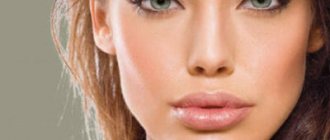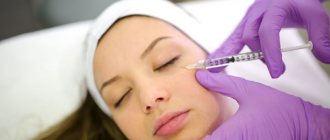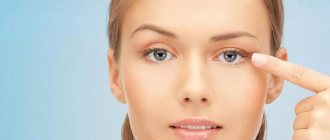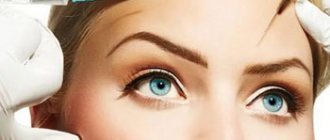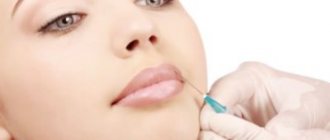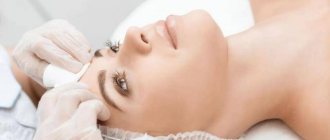How does botulinum toxin work and what is its danger to our body?
Pain in the head after beauty injections may occur after the first sessions. Their appearance is provoked by the active substance of the drug Botox. Botulinum toxin (Clostridium botulinum) is a powerful poison. When the toxin enters the human body in large quantities, it paralyzes the respiratory function: the drug has a neuroparalytic effect.
In medical practice, it is used in minimal doses to remove the muscle’s ability to contract and smooth the surface of the skin. The substance penetrates muscle tissue and suppresses nerve conduction. Because of this, the muscle tissue relaxes and stops temporarily contracting.
Botulinum toxin is used not only for aesthetic purposes. Botox for headaches is used to treat migraines. The product is injected into the neck, forehead and shoulder girdle. It relaxes muscles and relieves nervous stress. This helps relieve paroxysmal headaches.
Action of botulinum toxin
Headache after Botox is one of the private reactions to a toxin produced by the bacterium Clostridium botulinum. In itself, it is dangerous to human life. If ingested, it can cause muscle paralysis and even death.
However, the use of Botox in cosmetology is quite safe. The substance is used in minimal doses and injected directly into a specific area.
Botulinum toxin works by blocking the release of acetylcholine. The latter is found in nerve cells. It transmits impulse to muscle tissue and causes it to contract. In its absence, muscle cells are weakened and paralyzed.
The effect of Botox injections is not permanent. The reason for this is that nerve fibers have the ability to regenerate, which only takes a few months.
Why can I get a headache after Botox?
The effects of Botox appear gradually. The adaptation process lasts up to three days. During this period, adverse reactions may occur - headache is the most common reaction after Botox injection. At least 3 percent of patients face the problem of headaches and headaches. Factors causing painful symptoms in patients:
Response to microtrauma. When administering the drug, the needle touches the capillaries and injures its tissue. Inflammation that affects nerve fibers is inevitable. In this case, mild local pain may occur, which disappears after a couple of days.
Overstrain of muscle tissue. Injections into the area between the eyebrows and the frontal part relax the muscles in this part of the head, and the head begins to ache. Muscle tissue is used to hold the eyes open. Without support, the eyelids will begin to droop.
To return to its original state, significant tension is required in the muscles that were not subjected to the procedure. Their tension causes headaches. It takes two weeks to get used to such a load.
Intolerance. If there is an individual intolerance to Botox, an increase in blood pressure, deterioration of well-being, and the appearance of pain are possible.
If the symptoms are severe and physical health continues to deteriorate, hospitalization with medication is necessary. When you have a headache, not only Botox, but also an anesthetic cream can give such a reaction.
There are restrictions during the period of rejuvenation sessions. These include avoiding alcohol, intense sports, and the use of thermal procedures. Violations of the rules lead to bruises and minor hemorrhages. My head starts to hurt. The eyelid droops.
When should you not worry?
Headache begins after Botox injections into the forehead, which goes away after two days. It does not threaten your health and there is no need to worry. There is stiffness and a headache.
After combining with alcoholic drinks, the negative effects disappear after 5-7 days. There is no concern about muscle strain. Painful symptoms will disappear after 2 weeks as the muscles adapt.
If beauty injections were performed near the eyes, their effect relaxes the orbicularis muscles. To support weakened eyelids, active muscle tissues are tensed. The feeling of stiffness in the eye muscles is not only unpleasant, but also causes very severe pain in the head and eyes. Unpleasant symptoms disappear within 3 weeks or less.
Botox in the eye area can cause migraines that begin after injection. A painful reaction to light is one of the unpleasant symptoms. Sunglasses will help reduce pain during this period.
In other cases, the headache lasts no more than three days.
How to avoid complications
Talk to a specialist to find out if you should stop taking certain medications before getting Botox injections. This issue can be discussed at a preliminary consultation.
Drugs whose consumption should be limited:
- Painkillers (aspirin, ibuprofen).
- Antibiotics.
- Medicines taken for cardiovascular diseases.
- Medicines for the treatment of Alzheimer's disease.
- Remedies for neurological disorders.
- Vitamins and mineral supplements.
Avoid alcohol at least two days before your procedure as it may cause swelling and other side effects. Also limit sun exposure and avoid physical activity for at least 2 days before and after injections.
Can Botox injections cause headaches? Undoubtedly. Moreover, some experts argue that this is the body’s standard reaction to the introduction of a toxin.
However, one should not confuse mild discomfort with attacks of severe migraine, which does not go away within several days and is accompanied by nausea, fever and other symptoms. In this case, we are talking about a complication that requires treatment under the supervision of a doctor.
If “beauty injections” provoke the appearance of adverse reactions, consultation with a specialist will not be superfluous. This way you can recover quickly and avoid more serious consequences. If you don’t have the time or opportunity to visit a doctor, take a photo and send it to him by email. A professional will be able to assess the severity of the results and prescribe treatment.
In what cases is Botox not used?
There are restrictions when using cosmetic procedures with Botox injections:
- drug intolerance;
- with a blood disease;
- for infections and chronic diseases;
- pregnancy and breastfeeding;
- diseases of the liver, kidneys, stomach;
- with hormonal imbalances and weak immunity;
- oncological diseases;
- persons under 18.
The use of botulinum toxin cannot be combined with medications. My head starts to hurt from blood pressure lowering medications, antibiotics, and painkillers.
Muscle tone is impaired due to overexertion
When Botox injections are made into the eyebrows or forehead, the head muscles relax. The task of muscle tissue is to keep the eye open. As the muscles relax, the eyelids begin to close.
In order for everything to return to its previous state, the muscles that did not undergo the procedure will have to be strained. Painful sensations occur from muscle overstrain. It will take at least 10 days for the headache to stop bothering you.
Muscle tension in the forehead as one of the causes of headaches after Botox
Individual intolerance
Injections of this drug affect each person differently. If you notice that your health is suddenly deteriorating for no apparent reason, for example, your blood pressure is rising and the pain in your head is only increasing, then you are probably intolerant to Botox.
Symptoms of individual intolerance will not disappear on their own
You should call an ambulance and agree to hospitalization without hesitation. You will have to undergo medication treatment in the hospital.
When should you not worry?
If the needle enters a vessel, then Botox interacts with the capillaries: inflammation of the nerve fibers causes a headache, which quickly passes. You may also get a headache from the interaction of ethanol (alcohol) with the administered drug. When exposed to bright sunlight, a migraine can also begin, since you have to squint and thereby strain the muscles involved in the procedure.
All of the above symptoms will disappear after 3-4 days
Can Botox cause pain and dizziness?
A headache from Botox does not always signal a negative effect of the drug on the body. In most cases, this is a common symptom during the adaptation period, which lasts 3-4 days. This phenomenon is explained by the fact that during the administration of the drug the needle can touch the capillaries, which causes microtrauma.
Dizziness with intense headaches occurs after drinking alcohol. The cosmetologist should warn that you should not drink alcoholic beverages a week before the procedure and for 7-10 days after. Botulinum toxin has an effect on the body equivalent to alcohol, so combining them threatens to increase the intensity of pain.
You often feel dizzy after injecting a substance into the area around the eyes. Immediately after the procedure, the skin in these areas sags slightly due to relaxation of the muscle fibers. When supporting the skin in the process, active muscles tense, causing headaches that radiate to the eyes. In the normal course of rehabilitation, this syndrome gradually disappears over 1-2 weeks.
Advice! Injections into the orbicularis oculi muscle block the muscles and temporarily make squinting impossible. Sunlight entering the eyes causes headaches. You can prevent this unpleasant effect by wearing sunglasses.
Deviation from the norm
If the pain does not go away within 4 days and only becomes more unbearable, you should urgently seek help. This condition is especially dangerous when other symptoms are added to the pain: fever, nausea or vomiting. All these flu-like symptoms may indicate mistakes by the cosmetologist when performing injections. For example, if the amount of the administered drug was exceeded or the injection site was incorrectly calculated. Perhaps the person could not undergo this procedure due to some illness. He either kept silent about it or was not warned by the cosmetologist about contraindications and possible consequences. If you do not consult a doctor immediately, there may be unpleasant consequences: metabolic and circulatory disorders, hypotension (severe drop in blood pressure), kidney problems.
Headache after Botox: deviations from the norm
I probably have an intolerance to Dysport - I feel headaches.
In my opinion, Botox is somewhat milder in its effect than Dysport. I won’t argue, maybe these are my individual feelings. I have been injecting both of these drugs alternately since 2000. I came to the personal conclusion that doses of Dysport do not need to be injected into one place too large. The cosmetologist, with whom I have been friends all this time and with whom I am doing bold experiments on rejuvenation on the face and neck, assures that Dysport is now incredibly popular with clients.
It seems that this drug has a deeper and longer action. After Dysport, I get severe headaches, like migraines, that don’t go away for several days. I read about this drug, about its principle of action. It is believed that if the headaches do not go away within two weeks, then the injections were done incorrectly. But I have no doubt about the professionalism of my cosmetologist; there are many reviews about her work and all are positive. I come to the conclusion that I have a personal intolerance to Dysport.
Perhaps many are attracted by the relative cheapness of Dysport (compared to Botox injections), which is why this drug has so many fans. For me, it’s better to pay more than to suffer later. Plus (this is also my subjective opinion), the effect of the drug Dysport is somewhat shorter in time, in terms of rejuvenation results, than other drugs that are now offered in clinics and salons. Perhaps I’m wrong, and the effect of each drug is purely individual for each person. You should also take into account where the drugs are produced (manufacturing companies are now mushrooming like mushrooms after rain). After all, Dysport contains not only a “beneficial toxin”, but also other chemical additives that can cause allergens in different people. This is probably what I felt myself, I have no other thoughts.
Did you like the review? Thank the author! This will increase the overall rating of the review, so more visitors will be able to read it
Comments (2):
I had severe pain after this drug (injected into the forehead, between the eyebrows) lasted about two weeks. then everything returned to normal, but after 2.5 months (Dysport had not yet gone away), pain of a similar nature returned again. It is simply unbearable to endure, the terrible pressure on the scales and the back of the head. I went to a neurologist, did an MRI, an EEG, but studies show that everything is normal. Please tell me how long did your headaches last after Dysport was administered? And do they go away at all? Thank you.
After the injections (I do it once a year) - each time for several days, very painful sensations. Botox also hurts, but not as much. My cosmetologist has a special offer on Dysport, it turns out significantly cheaper, so I endure it))
Add a comment
Only site users can leave comments. Please register or log in to the site.
Hello! It’s already the third week since I put Dysport on the forehead. The forehead got up after two weeks, and now the eyelid and eyebrow have sagged in one left eye. All this time I have been feeling very bad, my temples have pressed on my forehead and forehead. Terrible headaches began. I no longer had the desire to be so beautiful. Is it possible to somehow return everything back? Or this torment will continue until the effect of the drug wears off. Thank you
Where can I get microcurrent therapy sessions? Where should I go?
Olga, to reduce the duration of Dysport, you can take a course of microcurrent therapy.
Irina, many beauty salons have devices. You need to look for one that is convenient for you and affordable.
Hello, three days ago I injected Dysport #8211 for the first time; 40 units to eliminate wrinkles between the eyebrows. Now it feels like the wrinkle has become deeper and a new vertical one has become noticeable! Could this be related to the effect of the drug?
Tatyana, in principle, it may be connected. You need to go to the doctor for an examination.
Hello. 2 days ago I did Dysport on the forehead and between the eyebrows. When can I go to the dentist to get implants after this procedure?
Vladimir, local anesthesia (and as I understand it, this is the issue) is not associated with blocking individual muscles, but it is better to wait until Dysport #8220;gets up#8221; definitively, that is, no earlier than in 2 weeks.
I'm on vacation#8230;. After sunbathing, my entire forehead was swollen#8230; Dysport injection in December#8230; It's March#8230; It feels like my forehead is completely filled with water#8230; What to do, recommend#8230; Spamibo
Ilona, it looks like some kind of allergy. Take Claritin or Suprastin and see a doctor if possible.
Hello, I have a Dysport injection on my crow’s feet for 12 hours, and fitness in the evening. Is it possible to actively engage in sports after 6 hours? and another 2 days after the injection, a trip to the dentist for a filling (with anesthesia). thank you
Elena, fitness is not necessary, and the dentist is not scary :)
and after the Dysport injection, on what day can you go to the gym (fitness. very active fitness)?? thank you.
Two weeks ago I did Dysport in the area between the eyebrows and on the crow’s feet, but there was almost no effect! crow's feet are as they were, and between the eyebrows #8211; So one wrinkle is almost unnoticeable, but the second, on the contrary, has become more noticeable and even lengthened, what do you recommend? Can this be corrected by reintroducing?
Every other day and not too intensely.
Irina, there are many reasons for the lack of effect. If it hasn’t taken off at all, then pinching it is unlikely to help.
In January I put Dysport in the forehead and between the eyebrows at the moment. Now it’s already April, my forehead hurts very badly. head, eyebrows pressing on the eyes. and the triangle between the eyebrows and on the bridge of the nose cannot be touched at all as it hurts. Is it possible to connect this with the effect of Dysport? At the moment I am being treated by a neurologist and are given medications to improve blood circulation (halidor, nootropil) and massage of the head of the forehead and cervical-collar area. but the tension and pain in the forehead area never go away. Is it POSSIBLE to associate this condition with the effects of Dysport? If yes, then how can I alleviate my condition? Thank you.
Which doctor should you contact regarding undesirable consequences after Dysport)
In January I put Dysport on the forehead and between the eyebrows. Currently, there is tension in the forehead, pressure on the eyes, the intervertebral triangle is painful to touch, all this is accompanied by discomfort and general malaise. I am currently receiving treatment from a neurologist, who is administering medications to improve brain blood supply (halidor, nootropil), massage of the head, forehead and cervical region, but so far there are no results of improvement. Is it possible to compare my condition directly with the effect of Dysport? Thank you.
Mechanism of action of Botox
Botulinum toxin, which is the active ingredient in Botox, is a toxic substance produced by bacteria of the genus Clostridium. Its action is based on blocking the transmission of impulses along the nerves.
Once in the human body, botulinum toxin inhibits the processes of nerve cells - axons. Because of this, the transmission of signal from the nerves to the muscle fibers stops, and the muscles cannot contract.
If the substance enters the human body in large quantities, then he develops botulism - a dangerous disease that often ends in death due to impaired contraction of the respiratory muscles. However, in small concentrations, botulinum toxin has a positive effect, which allows it to be widely used in cosmetology.
When botulinum toxin is injected into the skin, the nerve endings of the facial muscles are blocked, the transmission of signals for their contraction is disrupted, and therefore they relax. Outwardly, this is expressed in the fact that wrinkles on the forehead and cheeks completely disappear.
The procedure is carried out by experienced specialists who accurately calculate the concentration of the substance required to achieve a therapeutic effect. Despite the minimal content of botulinum toxin in the drug used, its administration affects the general condition of the nervous system. Therefore, after using Botox, you may experience a headache.
Pros and cons of the method
Using botulinum toxin to smooth out wrinkles has its advantages and disadvantages. The advantages of using the drug include:
- high efficiency of the procedure;
- minimal pain during the botulinum toxin injection procedure;
- long-lasting effect – at least 4-6 months;
- less likely to have complications and side effects compared to surgical correction;
- the possibility of use for preventive purposes, even before the appearance of deep wrinkles;
- short rehabilitation period.
Botulinum therapy also has a number of disadvantages. These include:
- the risk of going to an inexperienced doctor who will incorrectly calculate the dosage of the medicine and cause paralysis of the facial muscles;
- side effects - headaches, swelling under the eyes;
- ineffectiveness of Botox in correcting nasolabial folds;
- different duration of the effect – the possibility of rapid restoration of innervation due to the individual characteristics of the patient’s body.
Side effects after Botox injections occur in almost all patients, but in most cases they go away quickly. Therefore, the advantages of using the drug significantly outweigh the disadvantages. It is only important to choose a good specialist who will perform the procedures. With an experienced doctor, the likelihood of complications is significantly reduced.
Causes of headaches
Some clients who are injected with Botox develop antibodies that neutralize the effects of the injections. In this case, there will be no result. This mainly happens with long-term use of the drug.
There are mild and temporary side effects that include swelling, bruising and weakness. Why does my head hurt after Botox? There are several reasons. Let's look at them in more detail.
Response to microtrauma
Skin is the largest organ of the human body. It contains a huge number of blood vessels and nerve endings that are easily damaged.
Despite the fact that injections are made with thin needles, they can injure tissue. After this, local inflammation develops, causing pain.
As for the nerve endings, they are not always all switched off as a result of the administration of the drug. Some remain susceptible and transmit information about tissue injury through migraine attacks.
Muscle strain
It is not for nothing that it is recommended to undergo the procedure only from experienced specialists. After all, the positive effect of Botox largely depends on the correct dosage.
Failure to comply with this rule entails big problems, including impaired muscle tone. It is expressed as follows:
- Movement is impaired and eyelids droop. It takes a lot of effort to open your eyes.
- Severe pain appears. Since this reaction is more typical for the muscles of the upper half of the face, impaired tone is often observed with injections in the forehead and bridge of the nose. Consequently, clients experience discomfort in these areas.
- Swelling forms. In this case, the body reacts with a headache to tissue inflammation.
As a rule, side effects go away on their own after muscle adaptation and do not require medical supervision. If the headache caused by muscle strain gets worse, you should immediately contact a specialist for help.
Individual intolerance
Hypersensitivity to toxins can also cause headaches. As a rule, the development of an allergic reaction is additionally indicated by rashes at the injection sites. Sometimes they may be accompanied by itching and burning.
Sometimes these symptoms are supplemented by nausea, weakness and fever. In this case, to alleviate the condition, you need to take antihistamines. A consultation with the cosmetologist who performed the procedure is necessary.
Violation of rehabilitation rules
In most cases, judging by the reviews, side effects after Botox injections occur due to non-compliance with the requirements during the recovery period. Headache occurs if the client:
- stays in the sun or in a hot room (sauna, bath) for a long time;
- drinks alcoholic beverages in the first days after the procedure;
- exposes the body to great physical stress.
In this case, to get rid of unpleasant sensations, it is enough to stop violating the rules of rehabilitation.
Why might you get a headache after Botox?
Botox and headaches are often interrelated. Severe discomfort is a common side effect of using the drug.
Patients complain of dull, aching pain that is local in nature - located at the points where botulinum toxin was injected. Less commonly, the sensation is described as a nagging pain in the skull that radiates to the forehead. Unpleasant sensations normally last up to 2-3 days, less often they bother you for several weeks. The intensity of pain depends on the physiological characteristics of the patient’s nervous system.
The causes of headaches after botulinum toxin injection are divided into several main groups depending on their origin. These factors can have a complex effect on nerve endings, which causes side effects of the drug.
The soft tissues of the face have a number of features that contribute to their damage. These include:
- There are many vessels in the skin and muscles of the face, so when administering the drug it is impossible not to touch the walls of the capillaries. The needle used during the procedure, despite its small size, injures the vessels. Local inflammation develops at the site of drug administration, which is manifested by dull pain;
- facial skin has a large number of nerve endings. When Botox is administered, many of them are switched off, but some fibers may retain the ability to transmit information to the brain. If soft tissues are injured, the brain receives information about the impact on the body, and the patient feels pain and discomfort.
Unpleasant sensations caused by the reasons listed above are usually mild. Symptoms disappear almost immediately, as the skin of the face has the ability to quickly regenerate.
What to do if you have a headache after a Botox injection
Headache is a common side effect that should not scare a woman after a Botox procedure.
To understand what to do to relieve an unpleasant symptom, it is necessary to correctly assess the nature of the pain and determine whether you need to see a doctor. If the pain is mild enough and persists for no more than two weeks, then it can be considered a typical reaction of the body to botulinum toxin.
If, after administration of the drug, severe pain suddenly occurs, which is accompanied by other symptoms (vomiting, fever, tachycardia), then it is worth suspecting the presence of hypersensitivity to the drug or exceeding its permissible dosage. In this case, it is imperative that the woman be examined by the attending physician.
Typical attacks of pain are easily relieved with the help of analgesics. The most commonly used drugs are from the group of non-steroidal anti-inflammatory drugs. To select a specific product and determine its required dosage, you must first consult with a specialist.
If you have a headache from Botox, then a woman is recommended to massage the collar area. Stimulating this area promotes blood flow to the head. Normalization of blood circulation ensures sufficient supply of nutrients to injured tissues, which ensures their rapid regeneration.
A good way to combat headaches is aromatherapy. Essential oils have a beneficial effect on the nervous system and improve muscle tone. An additional positive effect of the procedure is the relief of nervous tension, which is often present in women after Botox injections.
Questions for specialists
Ideally, a problem that has arisen, such as a post-Botox headache, should be eliminated by the same specialist who performed the rejuvenation procedure. But it is easier to prevent negative consequences than to make efforts to eliminate them. How to achieve this can be learned from the answers of experienced cosmetologists to the most common questions of women who have decided to resort to “beauty injections.”
When to see a doctor
Each body is individual, so the rehabilitation period is different for everyone. If you have a headache for more than three days after Botox injections, and antihistamines and painkillers do not help, you need to consult a doctor.
You should also pay attention to the nature of the pain in the head: if the result of Botox is aching pain, an ice compress will help relieve it; if the pain is acute and throbbing, it is better to consult a neurologist.
How to avoid negative effects from Botox
In order not to suffer from headaches after Botox injections, you need to carefully listen to all the recommendations of the cosmetologist and follow them unquestioningly:
- For 10-14 days, give up alcohol and nicotine;
- Do not touch the toxin injection sites with your hands;
- Avoid exposure to sunlight.
If the pain has already attacked, anti-inflammatory drugs will help, which will reduce pain without affecting the distribution and action of botulinum toxin. Take tablets every 5-6 hours as needed until pain symptoms disappear.
To the question whether a headache can occur after Botox or not, the cosmetologist will not definitely answer (without the presence of obvious provoking factors). Therefore, it is recommended to administer the drug in small doses at intervals of at least 4 months. In this case, the effect may not be achieved so quickly, but the risk of complications is minimized.
Prevention of headaches
Headaches after Botox can be prevented if you take preventive measures in advance:
- Avoid high temperatures (bath, sauna, beach, solarium) for 2-4 weeks.
- On the day of the procedure, do not apply makeup, do not take a horizontal position and do not tilt your head in different directions.
- Do not resort to heavy physical activity and active sports.
- Do not take antibiotics or muscle relaxants.
- In the first hours after Botox, you need to make active facial movements so that the drug is evenly distributed in the tissues and does not cause complications in the future.
Prevent pain and other side effects such as rash, redness, itching
If Botox causes a headache, it is possible that a rapid test for allergies was not performed before the procedure, and now, in addition to pain, the patient may experience redness, rash and itching.
Important! The rapid test consists of an incision into a shallow wound on the wrist, which is treated with a few drops of botulinum toxin. If visible allergy symptoms appear after 30-40 minutes, it is better to refuse Botox.
A specialist’s opinion on the question of why a headache may hurt after Botox and what to do about it, watch the video:
Precautions and contraindications
Despite all the positive qualities, Botox is a rather dangerous drug. Therefore, before its administration, a complete examination of the woman’s body is carried out to identify possible contraindications. These include:
- inflammatory processes and allergic skin reactions;
- infectious diseases;
- period of pregnancy and lactation;
- disorders of the immune system (immunodeficiency states);
- exacerbation of chronic diseases.
It is recommended to first consult with an experienced cosmetic surgeon at the clinic about the possible consequences of the procedure.
If there are any contraindications, then it is necessary to refrain from administering botulinum toxin. It is prohibited to use the drug if you are allergic to its components, since it is impossible to predict the body's reaction to the administration of the drug.
Thus, headaches after Botox are a common complication that can be caused by various factors. If discomfort occurs, treatment is usually not required. However, if severe pain occurs, accompanied by other symptoms, the patient should be examined by the attending physician to exclude severe adverse reactions.
The most important contraindications and side effects of Botox
Botox is a very popular procedure, but despite its high effectiveness, it is not suitable for everyone. Therefore, before rejuvenation, you should definitely consult a doctor. If there are contraindications to the procedure, another drug or an alternative method of smoothing out wrinkles will be selected.
Did you know? Botox can be used not only in the fight against aesthetic defects in appearance. The drug also relieves migraines. To do this, Botox is injected into the head (forehead area). It could also be the shoulders or neck that put stress on the nervous system.
Paradoxically, rejuvenation with these injections can cause headaches. Often the reason for this is a violation of the main contraindications:
| Contraindications | Side effects |
| Pregnancy, breastfeeding; | Hematomas and bruises; |
| Dermatological diseases and mechanical damage to the integrity of the skin at injection sites; | Facial asymmetry; |
| Infectious diseases; | Infectious blood poisoning; |
| Acute course of chronic diseases; | Swelling, numbness; |
| Oncology; | Violations of facial expressions; |
| Individual intolerance to the drug; | Facial muscle spasms; |
| Diseases of the gastrointestinal tract, kidneys, liver; | Drooping eyebrows or eyelids; |
| Neurological and endocrine pathologies; | Headache; |
| Reduced immunity; | Watery eyes and diplopia (double vision); |
| Diseases of the blood (in particular hemophilia) and the cardiovascular system. | Muscle weakness, nausea. |
Dizziness is one of the most common consequences of Botox injections, even if they were not injected into the head. The appearance of this and other side effects can be caused by individual intolerance to the administered drug, unprofessionalism of the cosmetologist, or non-compliance with recommendations during the rehabilitation period.

